Episode 156: STS-78 - International Space.. Shuttle (LMS)
Table of Contents
On STS-78 we’ve got a bunch of materials science, a bunch of muscles to study, and a bunch of wake-up songs to roll our eyes at. Let’s just hope we have enough fuel to make it to orbit in the first place!
Episode Audio #
Photos #
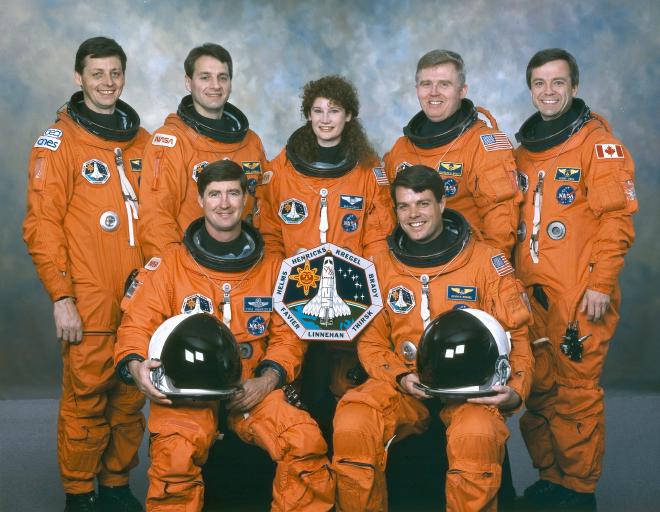
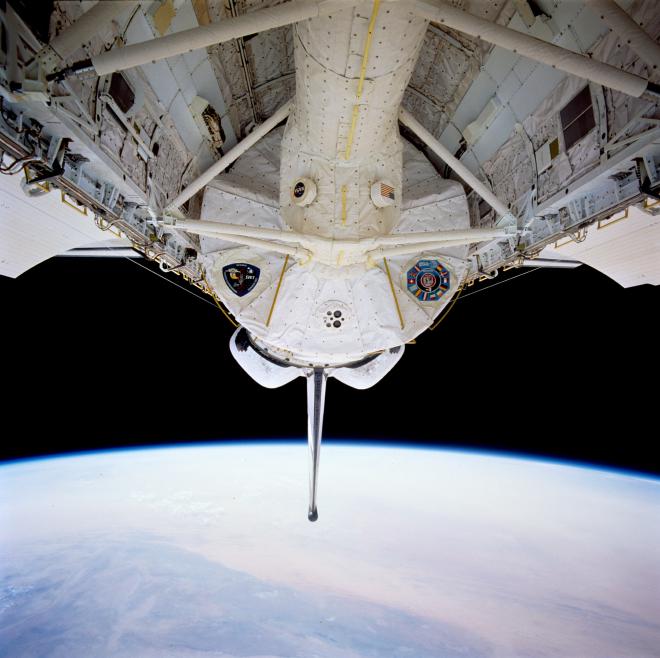
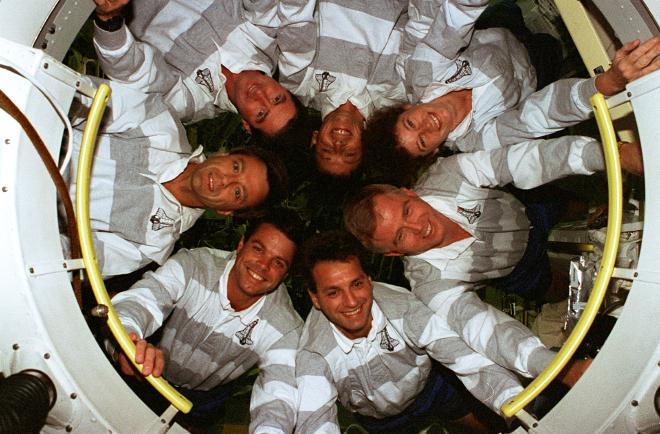
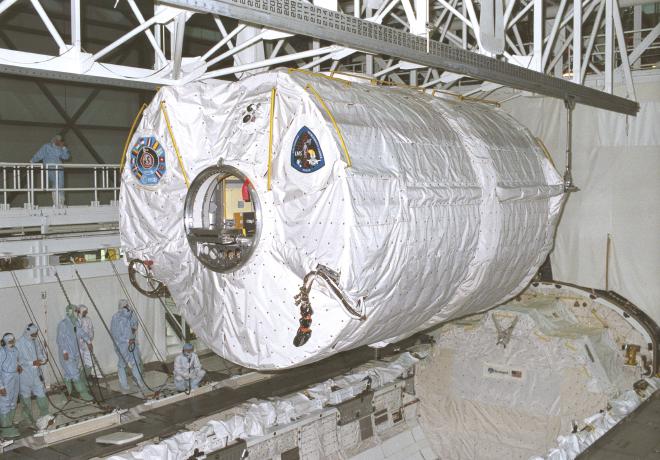
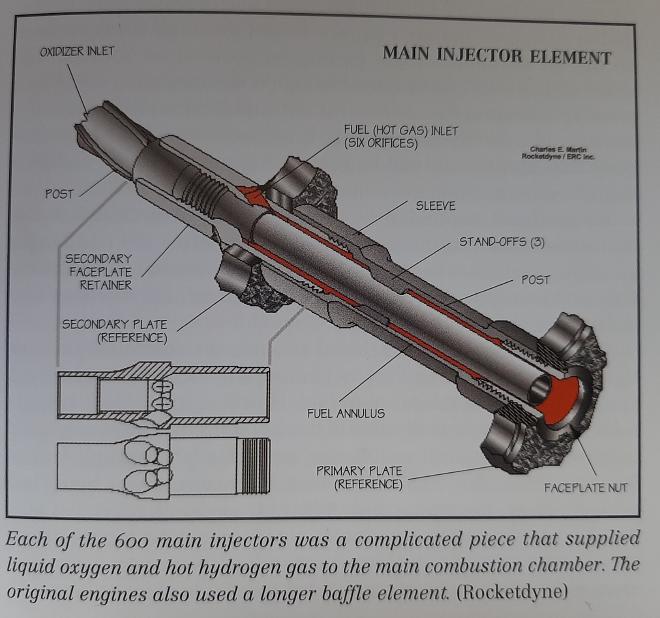
Cockpit Launch Video #
Cockpit Landing Video #
Post-Flight Presentation #
Wayne Hale Blog #
And if you’re not reading it already, Wayne Hale’s excellent blog, which was especially helpful for the fuel mixture section of this week’s episode, is available at https://waynehale.wordpress.com/.
Transcript #
NOTE: This transcript was made by me just copying and pasting the script that I read to make the podcast. I often tweak the phrasing on the fly and then forget to update the script, so this is not guaranteed to align perfectly with the episode audio, but it should be pretty close. Also, since these are really only intended to be read by myself, I might use some funky punctuation to help remind myself how I want a sentence to flow, so don’t look to these as a grammar reference. If you notice any egregious transcription errors or notes to myself that I neglected to remove, feel free to let me know and I’ll fix it.
Hello, and welcome to The Space Above Us. Episode 156, Space Shuttle flight 78, STS-78: International Space.. Shuttle
Last time, we covered the action packed flight of Space Shuttle Endeavour on STS-77. We deployed a chaotic and somewhat wacky inflatable antenna experiment, we glossed over a whole ton of middeck experiments, and we chased down the PAMS subsatellite for rendezvous after rendezvous after rendezvous. Oh, and for some reason we made carbonated drinks for Coca Cola.
Today instead of chasing down multiple rendezvous targets we’ll be turning our attention inward. No, not to the crew cabin, keep going; because we’ve got Spacelab in the payload bay, and we’ll be spending the flight studying how stuff behaves in space as well as the physiology of the crew members themselves. Let’s just jump right in and meet them.
Commanding the mission is Tom Henricks, who we last saw commanding STS-70, which deployed TDRS-G. This is his fourth and final mission, with his first being STS-44.
Joining Henricks up front as Pilot is another familiar face, both to us and Commander Henricks. That’s because Pilot Kevin Kregel was also the Pilot on STS-70. It’s times like this that I wish I had actually gotten around to making a queryable astronaut database because I’m pretty sure that this is the first time in the shuttle era that a Commander and Pilot have flown together on a second flight. A quick search leads me to believe this is, in fact, the case, but as always, corrections are welcome at jp@thespaceabove.us. This is Kregel’s second of four flights.
Moving back in the flight deck we meet Mission Specialist 1, Richard Linnehan. Richard Linnehan was born on September 19th, 1957 in Lowell, Massachusetts, but grew up in nearby New Hampshire. He earned a Bachelor’s degree in Animal Sciences from the University of New Hampshire, following it up with a Doctorate of Veterinary Medicine from the Ohio State College of Veterinary Medicine five years later. So while we’ve had quite a few astronauts who were veterans, this makes Linnehan the first astronaut who was a veterinarian. And I’m sure I’m the first person to comment on that fact, for sure. But it turns out Linnehan was actually both since after a two year internship at the Baltimore Zoo and Johns Hopkins University he became a captain in the US Army Veterinary Corps. Somehow he ended up as the chief clinical veterinarian for the US Navy Marine Mammal Program, but I’m going to guess that the veterinarians across the various military branches are pretty friendly with each other. When the call came from NASA in 1992 he was working in the water in the San Diego Harbor. He got back to the office and discovered several post-its informing him that NASA had called eight or nine times. When he finally got NASA on the phone and heard the good news that he had been selected as an astronaut he ran down the pier and jumped into the harbor in celebration. This is his first of four flights.
Mission Specialist 2 and Payload Commander for this flight is someone we’ve flown with a few times now, Susan Helms. When we last saw Helms she was also serving as flight engineer but on STS-64, which among other things tested the EVA emergency rescue jetpack “SAFER”. She’ll be helping the pilot crew out on this flight while the science crew keeps busy getting poked and prodded and growing crystals and stuff. This is her third of four flights.
Moving downstairs, we find Mission Specialist 3, Chuck Brady. Charles Brady was born on August 12th, 1951 in Pinehurst, North Carolina. He did pre-med at the University of North Carolina at Chapel Hill before receiving his Doctorate in Medicine from Duke University. For seven years Brady put his medical knowledge to use in a family practice as well as in sports medicine, including as Team Physician for Iowa State University. In 1986 he joined the Navy and became a flight surgeon at the Naval Aerospace Medical Institute in Pensacola, Florida, as well as servicing on aircraft carriers. Taking the cake for flashiest former job in this crew, he also spent two years with the Navy Flight Demonstration Squad.. better known as the Blue Angels. He was servicing in Tactical Electronic Warfare Squadron 129 when he was selected as an astronaut in 1992. This is his first and only flight.
Rounding out the crew we also have a couple of Payload Specialists. Payload Specialist 1 was Jean-Jacques Favier. Jean-Jacques Favier was born on April 13th, 1949 in Kehl, Germany. He earned a degree in Engineering from the National Polytechnical Institute of Grenoble, along with a PhD in Engineering from the Mining School of Paris, and another PhD in Metallurgy and Physics from the University of Grenoble. After servicing in a variety of science roles, he was selected as an astronaut candidate by the French space agency in 1985. He was the Principal Investigator for the MEPHISTO experiment which we saw fly on STS-52 and STS-62, and he also served as backup Payload Specialist on STS-65, the second International Microgravity Lab flight. This is his first and only flight.
And finally, someone who’s waited a long time for me to get through this crew list, but a much longer time to find himself on a crew at all: Bob Thirsk. Robert Thirsk was born on August 17th, 1953 in new Westminster, British Columbia in Canada. He earned a Bachelor’s degree in Mechanical Engineering from the University of Calgary, a Master’s in Mechanical Engineering from MIT, and a Doctorate in Medicine from McGill University. Soon after that he was scooped up in Canada’s first group of astronauts, servicing as Marc Garneau’s backup for STS-41G. 13 years is a long time to wait for a flight, but hopefully it wasn’t too painful because it’ll be another 13 for his next one. This is Thirsk’s first of two flights.
If you’ve noticed this crew’s international composition, then a gold star for you. This flight is another in a series of flights that is more or less a prequel to how things will run on the International Space Station. We’ve got a bunch of experiments studying a bunch of different fields supplied by and operated by people from a bunch of different countries. But first.. we need to get it into orbit.
At first glance, the launch of STS-78 seemed to go completely by the books. With no scrubs and no delays, Space Shuttle Columbia lifted off for its 20th trip into orbit on June 20th, 1996, at 10:49 AM Eastern Time. 8 minutes and 29.6 seconds later the main engines shut down, the external tank was jettisoned, and Columbia continued on to begin its mission. But things aren’t always as simple as they appear.
First off, while this wasn’t apparent until after the mission, the solid rocket boosters on STS-78 suffered not one, not two, but six cases of blow-by in their field joints. Considering that there are only six field joints total between the two motors, this means that 100% of the field joints experienced blow-by. In case your memory has faded a bit on this, blow-by is the name for the phenomenon where hot combustion gases from inside the SRB force their way down gas paths in the propellant and sealant and rush past the o-rings that seal the large joints during assembly. It was a severe problem early in the shuttle program and, of course, lead to the loss of Space Shuttle Challenger and its crew on STS-51L. Thankfully for the STS-78 crew, the solid rocket motors were now the redesigned solid rocket motors. The redesign had added a structure to the field joints called a “capture feature” which was essentially designed to prevent exactly what happened to the Challenger. The difference was that in order to escape the joint entirely, hot gases now had to take an additional 180 degree turn and pass a third o-ring, which they were not able to do. So to be clear, it seems that the STS-78 crew were not actually endangered by this alarming development, but it was clearly something that needed to be addressed. Suspicion fell on the fact that the Environmental Protection Agency had forced NASA to change some chemicals used in adhesives and cleaning fluids associated with the SRBs, but I should be able to give more detail in the next episode. That’s because the next flight is STS-79, which was supposed to go pick up Shannon Lucid, and now you know why that flight was delayed by two months.
But the SRBs weren’t the only cause for concern during ascent. The damage to the field joints wouldn’t be discovered until after the SRBs had been fished out of the ocean, towed back to land, and disassembled and inspected. The other problem was apparent only a few seconds after arriving in orbit. 2.3 seconds after main engine cutoff, sensors in the External Tank’s hydrogen tank reported that they were dry. This was.. very bad! But to explain why we’re gonna have to do a quick review of the Main Propulsion System of the space shuttle.
While the SRBs are big, flashy, and loud, it’s actually the three space shuttle main engines that do most of the work of getting the shuttle into orbit. These engineering marvels burn hydrogen and oxygen in ludicrous quantities, channeling those burning gases out through big nozzles at the back of the orbiter. Since the orbiter doesn’t have room for the required amount of hydrogen and oxygen propellant, it’s kept in the External Tank. Hydrogen and oxygen are pumped from the tank through big pipes that enter through the belly of the orbiter and feed the engines.
One tricky aspect of running these engines is that it’s really important that they are fed both fuel (hydrogen) and oxidizer (oxygen) at a specific rate. If either were to run out completely, the engines would suck in a big blob of nothing where it expected something and a bunch of rapidly spinning machinery would lurch forward and tear itself apart in a catastrophic failure. For that reason, there’s always a little extra propellant in the tank. Engineers try to minimize that extra propellant since each kilogram of wasted propellant is a kilogram that could have gone towards more payloads. Even with that goal though, there are still usually a few hundred kilograms of extra propellant at main engine cutoff.
And while the amount of propellant is important, so is its mixture. If you want to burn hydrogen and oxygen with maximum efficiency, you want two hydrogen atoms for every one oxygen atom. And yes, that means that instead of a bunch of nasty soot or toxic chemicals, all that comes out of the back of the shuttle main engines is H2O: water. Since hydrogen has an atomic weight of one and oxygen has an atomic weight of sixteen, we get an ideal mixture ratio of 8. That is, the sixteen from the oxygen divided by the two “one”s from the hydrogen comes out to 8. After some real world engineering compromises, such as not running the combustion too hot, the actual mixture ratio used by the shuttle was 6.03. If the ratio is higher you’ll burn oxygen faster and get too hot. If it’s lower, you’ll burn hydrogen faster and be less efficient. Squirrel that bit of information away because it’ll be relevant in a minute or so.
Inside the shuttle main engines, as you might expect, things are a little complex. When you’re mixing and burning hundreds of kilograms of propellant per second in a combustion chamber that can fit in the front seat of a car then the engineering required is non-trivial. In order to get the propellant into the combustion chamber, hydrogen and oxygen is forced through a device that basically looks like a shower head with 600 holes: the main injector. Upon closer inspection you would see that each of the 600 injector elements isn’t just a hole, but is essentially an open pipe with another open pipe inside it. Imagine sticking a thin straw down the center of a thicker straw and you’ve got the right idea. Oxygen comes out the inner straw and hydrogen comes out the outer straw. The whole thing is called a post, and 600 of these posts are what you see when you look at the main injector.
Since the main engines are used multiple times, these elements have multiple opportunities to pick up some wear and tear from normal operations. Since it would be extremely bad if this post broke off, technicians would inspect them and look for sign of damage. When sufficient damage was found, a gold pin was inserted at the top, where the oxygen came in. This basically deactivated the inner straw and made it inert.
So again, the main engines have an injector that looks like a shower head with 600 holes. Each hole has an inner pipe with liquid oxygen and an outer pipe with liquid hydrogen. Sometimes the inner pipe gets damaged and so is intentionally plugged up from the other end, where the oxygen would enter. Pretty normal thing so far. Except.. when you plug a oxygen post, now there is one fewer oxygen post. On Columbia, enough of these posts were pinned that the fuel to oxygen mixture was off just a little bit. Instead of 6.03 it was down around 6.002. That’s 0.028 lower for those of you trying to do the math in your head. Time to review that information we squirreled away earlier.
The ideal mixture is 8.0. After engineering compromises the shuttle ran at 6.03. A higher number means more oxygen and a hotter flame, and a lower number means more fuel and less efficiency. So now that we know Columbia was running 0.028 lower thanks to these pinned posts, we can see why it ran out of fuel just a few seconds after main engine cutoff.
OK so.. who cares? Like I said, it was after main engine cutoff, right? Sure, but just by chance. If the mixture had been just a little bit further off, the fuel could have run out a few seconds before MECO. In such a case, those same low level sensors would raise the alarm and the main engines would shut down, leaving Columbia in a lower orbit. Or maybe not even an orbit at all. But if those sensors failed, suddenly the mixture would become much more oxygen rich, raising the mixture ratio. And what happens when we raise the number? Things get hotter. And since everything is already running close to the highest temperatures it could handle, this would cause the engine.. to explode.
So the best case scenario of running out of fuel early is a lower than expected orbit, perhaps affecting the mission or even requiring an emergency landing. And the worst case would be a loss of crew and vehicle in low earth almost-orbit. So yeah, you can see why shuttle flight director Wayne Hale correctly noted that in this case no harm was done, but it quote “scared the bejabbers out of everybody.” It’s also perfect foreshadowing for another main engine problem we’ll see 17 flights from now, but that’s a story for another day. For now, just know that the mixture ratio on future flights was updated to take into account the presence of these pinned posts and the program rolled on.
That was a lot of technical detail to start the flight off with, so how about we return to the crew cabin and remember just how magical this all really is. Mission Specialist Richard Linnehan recalled quote “My first job was to take pictures of the External Tank as it separated with a huge camera lens and I had to wedge myself in the window and take these pictures. As you looked down, there’s the tail of the orbiter and just the Earth and the oceans. Everybody was around the aft windows … and no one said anything. There was nothing to say.”
Within an hour after arriving on orbit, the payload bay doors were open, almost everything down in Spacelab was activated, and the crew were raring to go. Instead of whizzing all around low earth orbit on four rendezvous like the previous mission, Commander Henricks and Pilot Kregel put Columbia into a gravity gradient stabilized attitude, with its tail facing down towards the Earth. This would keep the onboard environment as stable and gentle as possible for the experiments lining the walls of Spacelab down in the payload bay.
So.. what do we have back there anyway? What we have is the Life and Microgravity Spacelab mission or LMS, and it was more or less exactly the type of stuff expected to be done on the upcoming ISS. But since it had been a few years since IML-2 and it would be a few years still to come before science could be done on the ISS, LMS would help fill the gap.
First, let’s hit on the materials processing experiments. ESA’s Advanced Gradient Heating Furnace spent the flight processing semiconductor samples and performing metallurgical experiments, presumably to the delight of metallurgy expert Payload Specialist Favier. The furnace had a number of experiments with names like “Equiaxed Solidification of Aluminum Alloy” and “Particle Engulfment and Pushing by Solidifying Interfaces.” Basically, scientists were trying to get a better idea of how materials behaved as they were cooling down, particularly the interface between the growing solid part and the still liquid part. What I learned is that “engulfment” is a fun word.
The Advanced Protein Crystallization Facility checked the box on the apparent requirement that every shuttle flight include some crystals. I know I sort of goof on all the crystallization experiments but there’s a reason they fly them. Space provides the perfect environment to grow these scientifically interesting crystals at a size and purity that’s simply not possible on the ground. On this flight, the crystals were focused on proteins important in biology such as RNA, Lysozyme, Nucleosomes, protein membranes.
The materials science side of things also saw the return of the Bubble, Drop, and Particle Unit which we’ve seen fly on previous missions. The BDPU would again be observing the formation and behavior of bubbles in various fluids of various temperatures, as well as capillary action, liquid bridges, and surface tension effects. A lot of this seems to be both basic research as well as getting a better handle on how to design complex space systems in the future. Want to build some big fluid-based heat exchanger for your new vehicle? You better have a good idea of how bubbles behave in space. That sort of thing.
But materials science was only half the story. Putting the L in LMS, we have life sciences. In particular, we’re going to be focusing on human adaptation to microgravity and the effects of microgravity on muscles. Just two hours after reaching orbit, Payload Specialists Favier and Thirsk started attaching electrodes and sensors to their bodies as part of the Canadian-made Torso Rotation Experiment. The goal here was to try to track the eye, head, and torso movements of the crew members during their first few hours in weightlessness and see how they adapted. Scientists were also hoping to learn what, if any, motions lead to particular distress.
And the human guinea pig trials didn’t end here. In fact, they had already been going on for a while. Starting almost two weeks before the flight through one week after, the science crew ate meals which included a special isotope of calcium. By tracking the presence of this isotope in regular blood drawings and uh.. waste deposits from the crew, it would be possible to gain more insight into how their metabolism and bones were changing.
The flight also made a big push to better understand how sleep and circadian rhythms are affected by spaceflight. Even setting aside the whole “zero gravity” thing, life on the shuttle is pretty weird. Every 45 minutes the sun either sets or rises. Considering the powerful role that sunlight has in influencing the daily rhythms of human sleep it’s pretty natural to wonder what happens to the brain when you get 16 days.. per day. With this in mind, a few days into the flight the science crew put on some temperature sensors and special hats before going to sleep. Those special hats were EEGs, devices that can detect the brainwaves of the wearer, allowing scientists to track how well they were sleeping. The crew wore them to bed for three days before setting them aside. Then, near the end of the mission they did it again for another three days. By doing this the hope was to see how their sleep patterns evolved over the course of the lengthy mission. These brainwave and temperature measurements were combined with a series of mood and performance tests to better characterize the crew’s daily rhythms and how it may or may not be affecting their performance.
Not everything can be as relaxing as eating weird food and sleeping with funny hats on, however. The crew also participated in a series of experiments designed to measure how their muscles were adapting to suddenly not being needed so much. It was already known that muscles would atrophy in weightlessness, but with long duration ISS flights coming up it was more important than ever to precisely determine how this process unfolded. Along with some tests we’ll talk about in a few minutes, the crew used devices like the Torque Velocity Dynamometer to measure the performance of their muscles, including how strong they were over time as well as when they became fatigued.
In order to help suss out what changes were caused by microgravity and what were caused by simply not using their muscles very much, volunteers on the ground spent similar amounts of time not in space.. but in bed. By remaining in normal gravity but spending a mission duration moving as little as possible, scientists could hopefully use the data from the volunteers to isolate changes in the crew caused specifically by microgravity.
This flight was a little unusual in that it was a Spacelab mission with only one shift, rather than the typical around the clock operations. I’m betting that with the presence of all the materials science experiments as well as the recent advancements in telescience, the goal was to create big blocks of time when the crew wouldn’t be bouncing around and sending vibrations through the orbiter structure. But it also means that the ground got to have a little fun waking the crew up every morning with music.
Clearly the ground relished their role in these pun-like selections. For their first wakeup call, the crew found themselves listening to Tom Petty’s “Free Fallin’” as they free-fell around the world. For mission commander Tom Henricks they played David Bowie’s “Space Oddity”, featuring Major Tom. The morning after a day off they were woken with “Back on the Chain Gang” by the Pretenders”. In reference to a lung function experiment that required the crew to wear some pretty intense looking masks, we get “Every Breath You Take” by The Police. We also got some France, Canada, and United States themed songs, several songs performed by the all-astronaut band Max-Q (featuring Mission Specialist Susan Helms on the keyboard), and on the second to last day of the flight: Don’t Bring Me Down by the Electric Light Orchestra. Oh those CAPCOMs, such funny DJs.
While most of the experiments weren’t too intrusive, there were a few that serve as a reminder that especially when it comes to science, it’s not all fun and games in space. The crew underwent muscle biopsies before and after the flight, with small samples of their muscles being cut out for analysis. Thanks to some local anesthesia it’s not quite as bad as it sounds but it does leave the sample site sore and tender and doesn’t sound like a great time.
But the worst had to have been the experiment titled “Effects of Microgravity on Skeletal Muscle Contractile Properties.” In this experiment.. actually, rather than me tell you about it, I’ll read a lengthy quote from mission commander Henricks. In the Smithsonian-published book “Space Shuttle: The First 20 years”, Henricks said quote
“I’m one of those non-scientist pilots who believes that doing medical experiments in orbit is part of an astronaut’s job. If you didn’t want to participate in that, why in the world did you ever put in your application? When so few humans to go space, we’d better get as much information as we can out of every person who goes. In my opinion, people who don’t want to participate in those experiments picked the wrong profession. But I know there are still some of them in the astronaut corps. Even if some of the experiments are painful, you get the trade-off of doing what so many people dream of doing -going to space- and I can give up a little blood for that. As a pilot, I didn’t really have it that bad. But the mission specialists on STS-78, who were there to do research, had it the worst. The most painful thing they had to endure was using an electrical charge to contract their calf muscles to their maximum contraction. That’s why I’m disappointed when I see astronauts who don’t want to participate in minor experiments that cause some discomfort. I saw these guys on STS-78 being so brave, and doing things that were extremely uncomfortable.”
And Henricks didn’t even mention that the electrodes were “percutaneous”. In other words.. needles stuck through the skin. Having my muscles contracted to the point of pain doesn’t sound great, but I’m with Henricks on this one. If it means I get to fly in space, sign me up.
The already lengthy flight was extended by one extra day to help collect all the science possible, but eventually it was time to button up Spacelab, get the pumpkin suits back on, and prepare for reentry. The weather in Florida behaved itself, and on the first try Columbia came tearing through the upper atmosphere before gently landing on the runway at the Kennedy Space Center. Folks who watched the reentry live on TV were able to see something that only an elite few had ever seen before: the view from the Commander’s window during the final approach and landing. Actually, the small lipstick-sized camera had also been used on ascent, positioned to the left of Henricks and allowing viewers to see the Commander and Pilot work during the ride uphill. But for reentry, the camera was repositioned to point out the front windows, giving a sense of what the pilot crew sees as they soar over Florida. I’ll be sure to include a link to the video in the announcement tweet for this episode, but it should be easy to find by just searching for “STS-78 landing”.
The flight’s incredible duration of 16 days, 21 hours, 47 minutes, and 35 seconds set a new high water mark for the shuttle era, but don’t get too used to it because we’ll be surpassing it one more time in just a few missions.
This flight strikes me as another one of these less-flashy but still critical missions that are so easy to pass by unnoticed. This is just me speculating, but I would bet that between all of the international coordination, the advances in studies of human physiology in microgravity, and the continued refinement of ground-operated telescience, this flight was more influential to how spaceflight operates in the present day than most of the more attention-grabbing missions.
I found two sources particularly useful for this episode and I’ve mentioned both before but thought they deserved another shout out. One is “The 20th Century in Space” by Ben Evans, and the other is shuttle flight director and program manager Wayne Hale’s blog. If you go look for Hale’s blog you should note that there is both an official NASA one as well as a personal one, and they’re both excellent.
Next time.. once we settle this pesky SRB problem, it’s time to bring Shannon Lucid home and deliver our next long duration Mir resident, the one and only John Blaha.
Ad Astra, catch you on the next pass.
